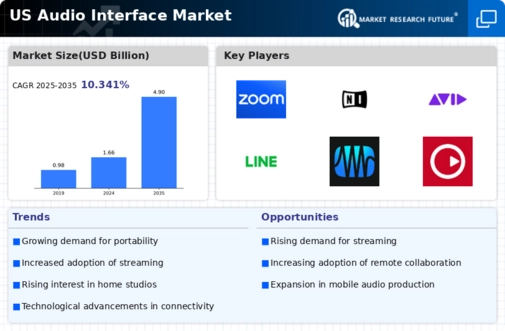Rise of Content Creation
The audio interface market experiences a notable surge due to the increasing number of content creators in the US. With platforms like YouTube, Twitch, and podcasting gaining immense popularity, individuals and businesses are investing in high-quality audio equipment. This trend is reflected in the market data, which indicates that the audio interface market is projected to grow at a CAGR of approximately 10% from 2025 to 2030. As more creators seek to enhance their audio quality, the demand for versatile and user-friendly audio interfaces rises, driving innovation and competition within the industry.
Expansion of Streaming Services
The expansion of streaming services in the US has a profound impact on the audio interface market. As platforms like Spotify, Apple Music, and others continue to grow, artists are increasingly focused on producing high-quality audio to stand out in a crowded marketplace. This trend drives demand for audio interfaces that offer superior sound quality and ease of use. Market data suggests that the audio interface market is expected to reach a valuation of $500 million by 2027, fueled by the need for artists to create professional-grade recordings for streaming. The audio interface market is thus positioned for robust growth as streaming becomes a primary medium for music consumption.
Increased Adoption of Home Studios
The trend of setting up home studios contributes to the growth of the audio interface market. With the rise of remote work and online collaboration, musicians, podcasters, and voice-over artists are investing in home recording setups. This shift is reflected in market statistics, which show that sales of audio interfaces have increased by over 15% in the past year alone. The audio interface market is adapting to this demand by offering products that cater to various skill levels and budgets, making professional-quality recording accessible to a broader audience.
Advancements in Digital Audio Technology
Technological advancements in digital audio processing significantly impact the audio interface market. Innovations such as lower latency, higher bit rates, and improved signal-to-noise ratios enhance the overall audio experience. The industry witnesses a shift towards interfaces that support high-resolution audio formats, appealing to both professionals and enthusiasts. Market data suggests that the adoption of USB-C technology is becoming prevalent, allowing for faster data transfer and improved connectivity. As these advancements continue to evolve, they are likely to shape consumer preferences and drive growth in the audio interface market.
Growing Interest in Music Production Education
The audio interface market benefits from the increasing interest in music production education across the US. Educational institutions and online platforms are offering courses that teach music production, sound engineering, and audio editing. This trend encourages aspiring musicians and producers to invest in quality audio interfaces as essential tools for their learning. Market analysis indicates that the demand for entry-level audio interfaces has risen, as students seek affordable yet effective solutions. Consequently, the audio interface market is likely to see sustained growth as more individuals pursue careers in music and audio production.
























Leave a Comment